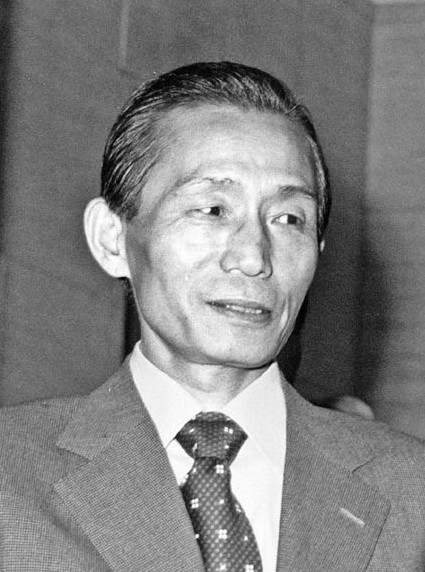(Created.) Tag: Visual edit |
(Japanese collaboration) Tag: Visual edit |
||
| Line 1: | Line 1: | ||
{{Infobox person|name=Park Chung-hee|native_name=박정희|birth_place=Gumi, North Gyeongsang, Korea|birth_date=1917 November 14|death_date=1979 October 26|death_place=Seoul, South Korea|death_cause=Gunshot wounds|nationality=Korean|image_size=200|image=Park Chung-hee.png}} | {{Infobox person|name=Park Chung-hee|native_name=박정희|birth_place=Gumi, North Gyeongsang, Korea|birth_date=1917 November 14|death_date=1979 October 26|death_place=Seoul, South Korea|death_cause=Gunshot wounds|nationality=Korean|image_size=200|image=Park Chung-hee.png}} | ||
'''Park Chung-hee''' was a dictator who ruled [[South Korea]] from 1961 to 1979. He came to power in 1961 through a military coup<ref>{{News citation|title=5·16군사정변|url=http://100.naver.com/100.nhn?docid=115821|newspaper=Doopedia|retrieved=2022-01-30}}</ref> and declared martial law in 1972 when he dissolved the legislature.<ref>{{Citation|year=2005|title=The Review of Korean Studies, Volume 8|page=201–203|publisher=Academy of Korean Studies|title-url=https://books.google.com/books/about/The_Review_of_Korean_Studies.html?id=iz8xAQAAIAAJ}}</ref> In 1979, he was assassinated by the leader of the secret police in 1979 and | '''Park Chung-hee''' (1917 November 14 – 1979 October 26) was a dictator who ruled [[South Korea]] from 1961 to 1979. He came to power in 1961 through a military coup<ref>{{News citation|title=5·16군사정변|url=http://100.naver.com/100.nhn?docid=115821|newspaper=Doopedia|retrieved=2022-01-30}}</ref> and declared martial law in 1972 when he dissolved the legislature.<ref>{{Citation|year=2005|title=The Review of Korean Studies, Volume 8|page=201–203|publisher=Academy of Korean Studies|title-url=https://books.google.com/books/about/The_Review_of_Korean_Studies.html?id=iz8xAQAAIAAJ}}</ref> In 1979, he was assassinated by the leader of the secret police in 1979, and [[Chun Doo-hwan]] established another military dictatorship in 1980. His daughter, [[Park Geun-hye]], was the president of South Korea from 2013 until her impeachment in 2017. | ||
== Collaboration with Japan == | |||
During the [[Empire of Japan (1868–1947)|Japanese]] occupation of Korea, Park took the Japanese name Takagi Masao, joined the [[Imperial Japanese Army]], and fought against Korean guerrillas including [[Kim Il-sung]].<ref>{{Citation|author=Stephen Gowans|year=2018|title=Patriots, Traitors and Empires: The Story of Korea’s Struggle for Freedom|chapter=The Patriot|page=67|pdf=https://ipfs.io/ipfs/bafykbzaced4iiga4ngtxusr2civjxewbili5jne2sbpefbx2s3im2kphattzc?filename=Stephen%20Gowans%20-%20Patriots%2C%20Traitors%20and%20Empires_%20The%20Story%20of%20Korea%E2%80%99s%20Struggle%20for%20Freedom-Baraka%20Books%20%282018%29.pdf|city=Montreal|publisher=Baraka Books|isbn=9781771861427|lg=https://libgen.rs/book/index.php?md5=8435F6FF91279531705764823FDC2A7F}}</ref> | |||
== References == | == References == | ||
[[Category:Politicians]] | [[Category:Politicians]] | ||
<references /> | |||
[[Category:Former heads of state]] | |||
Revision as of 14:28, 29 December 2022
Park Chung-hee 박정희 | |
|---|---|
 | |
| Born | 1917 November 14 Gumi, North Gyeongsang, Korea |
| Died | 1979 October 26 Seoul, South Korea |
| Cause of death | Gunshot wounds |
| Nationality | Korean |
Park Chung-hee (1917 November 14 – 1979 October 26) was a dictator who ruled South Korea from 1961 to 1979. He came to power in 1961 through a military coup[1] and declared martial law in 1972 when he dissolved the legislature.[2] In 1979, he was assassinated by the leader of the secret police in 1979, and Chun Doo-hwan established another military dictatorship in 1980. His daughter, Park Geun-hye, was the president of South Korea from 2013 until her impeachment in 2017.
Collaboration with Japan
During the Japanese occupation of Korea, Park took the Japanese name Takagi Masao, joined the Imperial Japanese Army, and fought against Korean guerrillas including Kim Il-sung.[3]
References
- ↑ "5·16군사정변". Doopedia. Retrieved 2022-01-30.
- ↑ The Review of Korean Studies, Volume 8 (2005) (pp. 201–203). Academy of Korean Studies.
- ↑ Stephen Gowans (2018). Patriots, Traitors and Empires: The Story of Korea’s Struggle for Freedom: 'The Patriot' (p. 67). [PDF] Montreal: Baraka Books. ISBN 9781771861427 [LG]